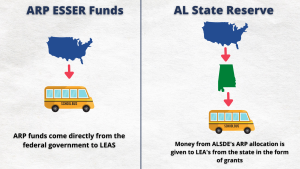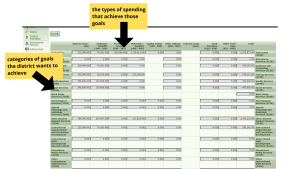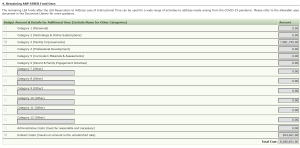District ARP applications can be found on egrant.alsde.edu. Watch the video below to learn how to find your district’s application, or keep reading below.
How to Find Your District’s ARP Application
- Open your browser and go to egrant.alsde.edu.
- Click “Search,” which can be found in the menu on the left side of the page.
- Type the name of your school district in the box to the right side of “Name,” then click search.
- Once you find your district, click the green dollar sign icon on the far right side, under the “Funding” heading.
- Once on the “Funding Applications” page, use the dropdown menu at the top to change the year to “2021”.
- Once on the 2021 “Funding Applications” page, look through the list of applications linked under “Entitlement Funding Applications”.
- If your district’s American Rescue Plan (ARP) ESSER application has been approved by the state, you will see a link to it. Click the American Rescue Plan (ARP) ESSER link.
How to Read Your District’s American Rescue Plan (ARP) ESSER Application
There are three categories of links on the landing page to the American Rescue Plan (ARP) ESSER Application: 1) Allocations, 2) Supplemental Information, and 3) Description. Below is a brief description of each category, including what you can find in each.
Allocations
The “Allocations” section lists how much money each district is receiving from the state. The first column labeled “ARP-ESSER” is the amount that the state is required to allocate to the district. The second column labeled “ARP-ESSER-SR” is the district’s allocation from the 5% states are required to spend on learning loss, which the ALSDE decided to give to districts through grant funding. Read more about how the state department is spending its portion of ARP funds here.
Supplemental Information
The “Assurances” section lists out the required actions from school districts in order to be in compliance with the state and federal governments as they receive and utilize ARP funds. “LEA Superintendent Assurances” provides a place for school superintendents to verify that they will abide by the assurances listed in the previous section. “Substantially Approved Dates” lists the dates that each portion of the ARP application was approved.
Description
This is the part of the application with all of the info on how this money will be spent. There are two sections in the Description box: ARP ESSER and ARP ESSER State Reserve. School districts were required to submit two separate applications for the separate pots of money.
 The State Reserve is the pot of money that the state was required to set aside to address learning loss, with 1% of state ARP funding going to summer programming, 1% to afterschool programming, and 5% to learning loss, for a total of 7% of the state’s ARP funds. The ALSDE decided to issue this money to districts through a grant process and each district has been able to decide how to use this money themselves, provided that the money went to summer, afterschool, or learning loss interventions. The application looks virtually the same as the main ARP ESSER application, with sections that are identical to the sections below.
The State Reserve is the pot of money that the state was required to set aside to address learning loss, with 1% of state ARP funding going to summer programming, 1% to afterschool programming, and 5% to learning loss, for a total of 7% of the state’s ARP funds. The ALSDE decided to issue this money to districts through a grant process and each district has been able to decide how to use this money themselves, provided that the money went to summer, afterschool, or learning loss interventions. The application looks virtually the same as the main ARP ESSER application, with sections that are identical to the sections below.
Budget
This section is a spreadsheet laying out all the funds being spent by the district by category. The rows down the left side are categories of goals the district wants to achieve, including but not limited to instruction, testing services, and social services. The columns along the top are budget categories for the types of spending that achieve those goals, and explains where specifically funds go to provide those services.
For example, for instruction, the amount that a district spends on salaries would be listed in the first row, first column. Keep in mind that this is only the funding that the district is spending from ARP ESSER funds or ARP ESSER state reserve funds, for the specific programs listed in the application.

Application Details
This section is the main portion of the application and includes all the written questions and answers as well as information on district plans on how they are spending ARP money. Information you can find here includes the Superintendent’s name, the district’s ARP ESSER Point of Contact (including their name, role, and phone number), and the URL for district’s return-to-instruction plan that is listed on each district’s website (at the bottom of required narratives).
The sections under Application Details are:
- Required Narratives- Each district is required to explain safe implementation of in-person instruction, use of evidence-based instruction, federal compliance, auditing, and community engagement in ARP plans.
- LEA Reservation to Address Lost Instructional Time- Each district is required to spend 20% of its ARP allocation to address the impact of lost instructional time due to the pandemic. In this section, there will be a smaller table with each category the state endorses as an evidence-based method to address lost instructional time, as well as an “other” category that districts can use as long as they provide documentation proving that the other method is evidence-based.
Below this table are explanations on how the district is using the money in each intervention category. Districts have no minimum or maximum number of interventions that they must use, so some districts may use their entire 20% on one intervention, while others may employ all intervention options.

Remaining ARP ESSER Use of Funds: This is where districts account for the remaining 80% of their allocation not required to go towards addressing lost instructional time. A similar table is found here with each category that districts can spend money on, as well as 6 options for “other” spending.
Following the table is space for districts to explain what the funding for each category is being used for. There are no other requirements on what these funds can be used for (outside of these allowable uses), so districts have free reign to spend these funds on the needs of their individual districts as they see fit.

Related Documents
Districts are required to provide job descriptions for all employees being hired with ARP funds. “Other” Evidence-Based Interventions is a section for districts to provide documentation for any interventions to address lost instructional time that are not endorsed by the state department (summer learning, afterschool programs, extended day, and extended year). Supporting Documentation #1 and #2 are places for districts to provide any other documentation necessary to support their application.
Checklist
This is a place for those completing ARP applications to check off that each portion of the application is completed properly.
So what? Takeaways for Families and Communities
Keep in mind that while the state department did provide example answers to intervention questions, each district’s answer will look different as they will not all answer in the same depth or provide the same amount of information. If after reading the plans, you have further questions about how the money will be used, reach out to your district and ask.


0 Comments on "COVID School Spending: How to Read Your District’s ARP Plan"